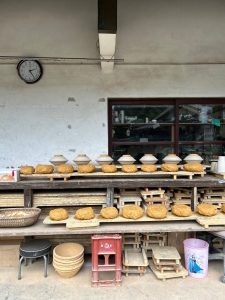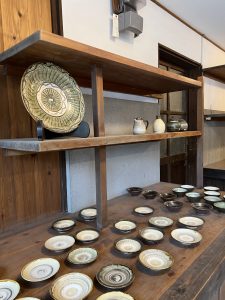小鹿田焼の里を行く(愛知県名古屋市千種区姫池通 骨董買取 古美術風光舎)
2024.09.26
皆さまこんにちは、スタッフYでございます。
少しばかり涼しくなりましたね。もう一生この暑さが続くのかと思うくらいこの涼しさのことを忘れかけていましたが、心地よい時期にはいりました。
そんなわけで、ここぞとばかりに先日ちょっと遠方へ足を伸ばしてみましたのですが、目的は、以前から興味のあった窯元巡りであります。訪れた感想を先に申し上げておきますと、今回は「ちょっと」どころではなかった笑。ですが、なかなか訪れられない地域でしたので、覚悟を決めて訪れてよかったので、本日はその報告をいたします。ご一読お付き合いくださいませ。
訪れた先は、大分県日田市にあります「小鹿田焼」(おんたやき)であります。

日田と言いますと、かつての天領、お水のが豊富で美味しい地域のイメージですが、小鹿田焼(おんたやき)は、日田市の市街地から更に車で50分くらい山あいを走った地域に位置する地区であります。その小鹿田皿山地区(日田市源栄町皿山(もとえまちさらやま))で焼かれる陶器のことを小鹿田焼というのですが、現在も機械を使わず手作りが続けられおり、その風景は昨年のブラタモリでも放送されておりました。その陶芸技法は1995年(平成7年)に国の重要無形文化財に指定され、2008年(平成20年)3月には地区全体(約14ヘクタール)が「小鹿田焼の里」の名称で、池ノ鶴地区の棚田とともに重要文化的景観として選定されている地区であります。
その小鹿田焼のはじまりは、江戸時代中期の1705年(宝永2年)若しくは1737年(元文2年)に、江戸幕府直轄領(天領)であった日田の代官により領内の生活雑器の需要を賄うために興されたもので、山を隔てた現在の小石原(現在の福岡県)から招かれた陶工の柳瀬三右衛門と、彼を招いた日田郡大鶴村の黒木十兵衛の資金提供のもと、同じく鶴河内村小鹿田の坂本家から土地提供を受け、皿山地区にて開窯。開窯から三百有余年、現在もこの地区の三家につながる人の一子相伝の習慣により九軒の窯元で作られております。
また民芸運動の創始者である柳宗悦もこの小鹿田焼にみせられ来窯、紀行文「日田の皿山」を著作。世界的に有名な陶芸家バーナード・リーチも来窯しており、昭和45年には、文化庁により「記録作成の措置により講ずるべき無形文化財」に選択され、平成7年には国の無形文化財に指定されております。

現在も三家につながる9軒の窯元で作られる小鹿田焼ですが、その製法や特徴も独特の作風でして。皿山地区で採取されえる土を、川の水を利用した唐臼でで20~30日かけ粉砕し、手作業で水簸、乾燥。すべてこの地域でおこなっております。また、平成8年(1996)には、川のせせらぎと独特な音が響き渡る唐臼の音が「残したい日本の音風景100選」にも選ばれておりまして、焼物だけでなくこの地区の風景までもが訪れてみたくなる場所なのです。

今回訪れてみたかったも、この風景をTVでみたことがきっかけだったのですが、小さな集落を穏やかに川が流れ、各窯元へ水を引き込み、そこへ唐臼が作られた風景をゆっくり歩きますと、川のせせらぎとその臼の音が山あいの集落にリズミカルに響き渡っております。道途中にあります唐臼をしばらく眺めておりましたが、その音とゆっくりと落ちる臼の動きの中に溶けていくような感覚が湧いてくるのでしが、つまりはしばらくぼー--っとしてたといいますか、気が付くとぼーっと唐臼を見つめておりました笑。
そして時間と手間をかけ唐臼によって作られた原土は水簸され、凝縮した泥水を「オロ」と呼ばれる濾過で水抜きし、乾燥されようやく陶土が完成。

ようやく職人により蹴轆轤を使って成形され天日干し、装飾が施されます。
小鹿田焼の伝統的な装飾として「飛び鉋」「刷毛目」「指描き」「櫛描き」などの図柄がありますが、もっとも特徴的な装飾の1つが、うつわに刻まれたリズミカルで面白い幾何学模様。これは、伝統的な装飾技法でカンナや刷毛を使ってひとつひとつ丁寧に描かれますが、この装飾もろくろを足を使って回転させながら行っていきます。

次に釉薬による伝統的な装飾にはいるのですが、作品に打つようにかける「打ちかけ」と作品全体にかける「流しかけ」があります。小物や濃い釉薬をかけたものには、割れやゆ釉薬が飛ばないように他とは別に素焼を行うそうでして、その後、器を窯まで運び登り窯に火を入れていきます。また、小鹿田焼には絵を描かいた装飾はないのも一つの特徴です。

また、この小鹿田焼には窯元の名を入れておりません。それは小鹿田焼が窯元全員で行う原土の採取から作品造りが始まる地域ブランドということで、地域が一つの価値観を持ちコミニティを形成し、それを伝承しているというのは窯業に関わらず現在の日本では珍しい仕組みでもあるなと思いました。

とまあ、ここまで述べてきた工程のすべて、山あいの地区をそぞろ歩きながら全部拝見することができます。それぞれの窯元のお家も「こんにちは」と、言いたくなるような田舎のお宅でして、その風景と共に川のせせらぎの音と唐臼で土を打つ音だけがゆっくりと山あいに響き渡ります。
本当に騒々しい日々の生活を一旦置いておきたくあるような時間でありました。
地区には日田市の小鹿焼工芸館もありまして、小鹿焼の歴史やその銘品なども展示されております。こちらもおススメですので、陶芸と共に癒されたい方にはぜひ一度訪れてみてください。ただし、他県からは、「えいやーっ」の気合が必要です。
それではごきげんよう。
Hello everyone, this is Staff Y.
It has become a little cooler. I had almost forgotten about the cooler weather, as if this heat would last forever, but it is now a pleasant time of year.
So I took advantage of this opportunity to go a little further afield the other day, and the purpose was to visit a kiln I had been interested in for some time. I have to admit that my visit was not “a bit” interesting. However, since it was an area that I do not get to visit very often, I am glad that I was prepared for the visit. Please read on.
The place we visited was “Onta-yaki” in Hita City, Oita Prefecture.
Hita is associated with the image of a former imperial domain, an area with abundant and delicious water, but Ontayaki is located about 50 minutes by car from the city center of Hita City in a mountainous area. The pottery produced in the Sarayama area (Sarayama, Motoe-machi, Hita City) is called Ojita-yaki, and is still handmade without the use of machines. The pottery technique was designated a national Important Intangible Cultural Property in 1995, and in March 2008, the entire area (about 14 hectares) was selected as an Important Cultural Landscape along with the terraced rice fields of the Ikenotsuru district under the name “Ojikada-yaki no Sato” (village of Ojikada pottery).
The origin of Ogada-yaki pottery dates back to 1705 or 1737, in the middle of the Edo period, when it was established by the deputy governor of Hita, which was under the direct control of the Edo shogunate, to meet the demand for daily utensils in his territory. The kiln was established in the Sarayama area with the financial support of Jubei Kuroki of Otsuru Village, Hita County, who invited San’emon Yanase, and land donated by the Sakamoto family of Oshikada, Tsurukawachi Village, also in Hita County. More than 300 years have passed since the opening of the kiln, and today, nine kilns continue to produce pottery based on the traditions passed down from one generation to the next by the three families in the area.
Muneyoshi Yanagi, the founder of the folk art movement, was inspired by Oshikada-yaki and came to the kiln, writing a travelogue entitled “Sarayama in Hita. In 1970, the Agency for Cultural Affairs designated the kiln as an “intangible cultural asset that should be documented” and in 1995, it was designated as a national intangible cultural asset.
Today, Kogada-yaki is still made at nine kilns connected to the three families, and its production method and characteristics are also unique in style. Clay collected in the Sarayama area is crushed using a mortar that utilizes river water for 20 to 30 days, then hand-weighed and dried. Everything is made in this area. In 1996, the sound of the millstone, which echoes with the murmuring of the river and its unique sound, was selected as one of the “100 Soundscapes of Japan to Preserve”.
I wanted to visit this village because I saw this scenery on TV, and as I walked slowly through the scenery where a river flows gently through a small village, water is drawn to each kiln, and a mortar is made there, the murmuring of the river and the sound of the mortar echo rhythmically in the mountain village. I looked at the millstones along the way for a while, and felt as if I were melting into the sound and the slow movement of the millstones, which is to say, I was in a daze for a while. It’s a millstone that makes you want to stare at it blankly for a while.
The clay is then sieved, the condensed muddy water is drained through a filter called an “oro,” and the clay is finally dried to produce pottery clay.
The clay is then dried and the potter’s wheel is used to shape the clay, which is then dried in the sun and decorated.
The most characteristic decoration is the rhythmical and interesting geometric patterns carved on the vessels. This is a traditional decoration technique in which each piece is carefully painted one by one using a canner and brush, and this decoration is also done by rotating a potter’s wheel with a foot.
Next comes the traditional decoration with glaze, which can be done in two ways: “uchikake,” which is applied as if striking the work, and “nagashikake,” which is applied to the entire piece. Smaller pieces and those with dark glazes are unglazed separately from the rest to prevent cracks and splashes of glaze, and then the pieces are brought to the kiln and fired in the climbing kiln. Another characteristic of Kogada-yaki is that there is no painted decoration.
Also, the name of the kiln does not appear on the pottery. This is because Kogada-yaki is a regional brand that begins with the collection of raw clay, which is done by all the kiln operators.
Well, you can see all of the above mentioned processes while strolling through the mountainous area. The houses of each kiln owner are so rural that you want to say, “Hello,” and with the scenery, only the sound of the murmuring river and the pounding of the clay with a mortar slowly echoes through the mountains. It was a time when I really wanted to put my noisy daily life aside for a moment.
In the area, there is also the Kogajiyaki Museum of Hita City, which displays the history of Kogajiyaki and its masterpieces. This museum is also highly recommended, so if you are looking for a relaxing experience with pottery, please visit there. However, if you are from other prefectures, you will need to have the spirit of “eeeeeeeeeeee!
Have a good day.
*******************
ご実家の整理やお片付けなどをされている方のご相談などが多くございます。
お片付けなどくれぐれもご無理のないようになさってくださいませ。
風光舎では古美術品や骨董品の他にも絵画や宝石、趣味のお品など様々なジャンルのものを買受しております。
お片付けをされていて、こういうものでもいいのかしらと迷われているものでも、どうぞお気軽にご相談下さいませ。
また風光舎は、出張買取も強化しております。ご近所はもちろん、愛知県内、岐阜県、三重県その他の県へも出張いたします。
まずは、お電話お待ちしております。
愛知県名古屋市千種区姫池通
骨董 買取【古美術 風光舎 名古屋店】
TEL052(734)8444
10:00-18:00 OPEN

